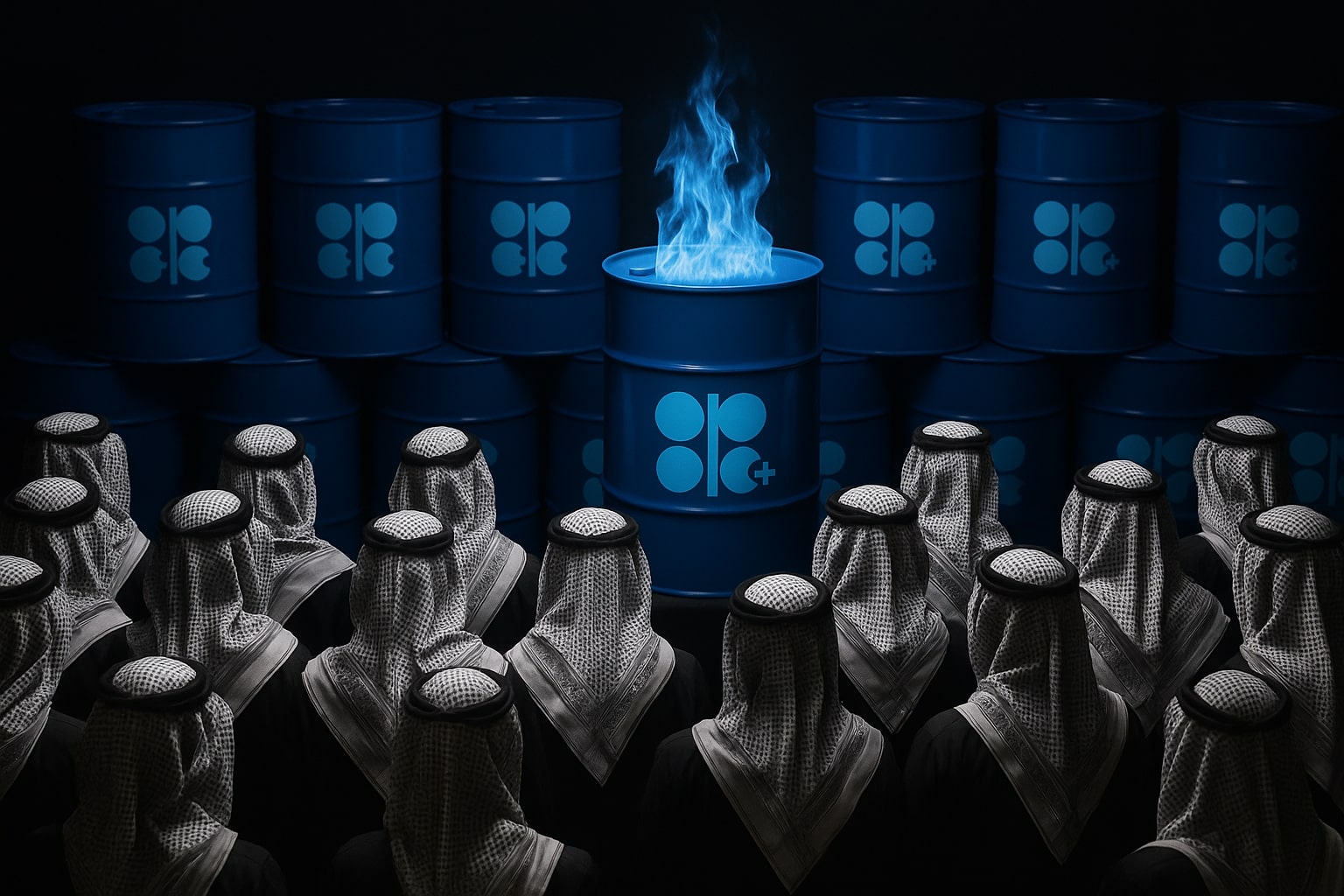
Natural Gas Price Steadies Near $4.40 as Record U.S. Supply and Weather Volatility Define Market
Natural Gas (NG=F) futures remain firm around $4.40, balancing record 111 Bcf/day production with colder U.S. forecasts that lifted prices earlier this week | That's TradingNEWS
Natural Gas Balances Record Production with Fragile Weather-Driven Demand
Natural Gas (NG=F) has stabilized near $4.40 after a volatile week marked by heavy contract rollover flows and sudden weather shifts. Earlier, futures hit an eight-month high as cold air spread across the Midwest and Northeast, driving short-term heating demand. However, the rally paused as updated forecasts introduced a milder pattern for the second half of November, forcing traders to reassess demand projections. Despite this cooling in sentiment, the market remains fundamentally supported by strong baseline consumption and geopolitical demand for liquefied natural gas (LNG).
At 14:30 GMT, December contracts traded at $4.398, up 1.38%, with bulls defending key technical support near $4.336. The past week’s pullback reflected both profit-taking and cautious repositioning ahead of fresh weather models. The energy price index compiled by the World Bank’s Pink Sheet showed that while crude oil prices dropped 5.1% in October, U.S. natural gas rose 7.5%, confirming that the gas market remains a notable outlier within the broader energy complex.
Record U.S. Output Creates Structural Headwinds for Bulls
Production has reached unprecedented levels. U.S. dry gas output hit 111.0 Bcf/day, the highest on record and 12% higher year-over-year, as shale basins ramped up winter drilling. The Baker Hughes rig count jumped to 128 active rigs, a 2.25-year high, signaling continued investment in upstream capacity. According to the EIA’s revised 2025 forecast, output will average 107.14 Bcf/day, exceeding earlier estimates and ensuring the market stays well supplied.
Despite record production, demand-side factors provided a buffer. U.S. consumption reached 94.7 Bcf/day, a 30% increase versus last year, while LNG exports held steady at 18.0 Bcf/day. The Lower-48 power generation data shows electricity output up 2.89% year-over-year, with incremental gas burn from utilities offsetting some production excess. However, the storage picture remains comfortable, with inventories 4.3% above the five-year average as of late October, signaling a limited near-term risk of shortages.
Weather Forecasts Keep Traders on Edge
The short-term temperature outlook is driving the speculative tone. Forecast models from NatGasWeather indicate that much of the eastern and central U.S. will experience another wave of cold air through midweek before warming into late November. This temporary easing in heating demand could cap prices below $4.52, but if late-month models shift colder, the market could quickly retest $4.75–$4.91 resistance levels identified by Economies.com.
The ongoing tug-of-war between short-term weather relief and longer-term structural demand has made $4.20–$4.52 the critical range to watch. Analysts see sustained trade within this band as a consolidation phase within a broader bullish channel. Breaking above $4.52 could attract fresh momentum buying, while a failure to hold $4.20 would risk a correction toward $3.95–$4.00, where prior rollover gaps have historically been filled.
Technical Landscape: Channel Support Still Intact
The natural gas chart structure remains constructive despite recent volatility. The market’s strong bounce from $4.20 confirmed that buyers remain active near prior breakout zones. Moving averages continue to slope upward, with the 50-day EMA near $4.27 serving as a key pivot. A close above $4.52 would open the path toward $4.75 initially and $4.91 if momentum persists.
Momentum indicators support this cautiously bullish stance. The RSI sits at 57, showing modest strength without overbought conditions, while the MACD line continues to hover above signal, reflecting steady buying interest. The trading range between $4.20 and $4.52 is now defined as a short-term accumulation zone, where both commercial hedgers and speculative traders adjust exposure ahead of the winter heating season.
Europe’s Storage and Global LNG Flows Add Bullish Undercurrent
Outside the U.S., structural demand signals remain supportive. European natural gas storage sits at just 83% capacity, below the seasonal average, raising the possibility of stronger transatlantic LNG demand if December turns colder. Asian markets continue to absorb steady U.S. cargoes as China and South Korea maintain elevated import levels. These global demand flows act as a backstop for U.S. prices, cushioning potential downside even when domestic fundamentals soften.
However, this support comes with risk. U.S. export terminals are already running near full utilization, meaning any operational disruption or unplanned maintenance could temporarily cap export volumes, increasing domestic supply and putting short-term pressure on NG=F prices. Traders are therefore closely tracking Cheniere and Freeport LNG facility data, which together account for more than 50% of total U.S. export capacity.
Read More
-
JEPI ETF Edges to $57.11 as Yield Holds Above 8% and Covered-Call Premiums Power Income
11.11.2025 · TradingNEWS ArchiveStocks
-
XRP ETFs Slide — XRPI Down to $14.18 and XRPR to $19.80 as Investors Lock In Gains After Record Run
11.11.2025 · TradingNEWS ArchiveCrypto
-
Oil Price Forecast - Oil Prices Edge Higher as Sanctions Tighten Russian Supply and Oversupply Fears Limit Gains
11.11.2025 · TradingNEWS ArchiveCommodities
-
USD/JPY Price Forecast - Yen Holds Near 154.00 as Yen Slides and Market Awaits Fed-BoJ Policy Shift
11.11.2025 · TradingNEWS ArchiveForex
Market Psychology and Positioning
Investor positioning remains mixed but biased toward optimism. After last week’s profit-taking, managed money accounts added long positions around the $4.35–$4.40 region, signaling renewed confidence that prices will remain supported into December. Volatility metrics such as the 14-day ATR have stabilized near 0.18, suggesting a reduction in intraday noise and an environment conducive to trend continuation.
Retail traders remain cautious due to the recurring rollover volatility that natural gas is known for. Historical data shows similar patterns: spikes on contract changeovers followed by short-lived retracements before resuming the upward trend. If this seasonal pattern holds, the next significant rally could emerge once the December contract fully absorbs speculative flows.
Macro Backdrop and Inflation Connection
The global macro landscape adds another layer of influence. The World Bank’s energy index decline of 3.7% in October—driven by falling oil but rising gas prices—highlights natural gas’s divergence from the broader energy complex. With inflation pressures easing and central banks slowing rate hikes, energy commodities may attract renewed institutional interest as defensive inflation hedges. In that context, NG=F could benefit from portfolio reallocation flows as traders seek exposure to assets less correlated with equities.
Final Take — Natural Gas (NG=F) Verdict
The data supports a Hold-to-Bullish stance. At around $4.40, Natural Gas (NG=F) is consolidating above strong technical support with firm demand tailwinds from both weather and exports. The record 111.0 Bcf/day output is a structural headwind, but rising consumption and global LNG demand create a balancing effect. If prices sustain above $4.52, the next upside targets sit at $4.75 and $4.91, while a break below $4.20 would shift sentiment back toward neutral.
Given the setup, NG=F remains Bullish short term, Neutral midterm, and a Buy on dips near the $4.20–$4.30 zone, especially if global temperatures turn colder into December.



















